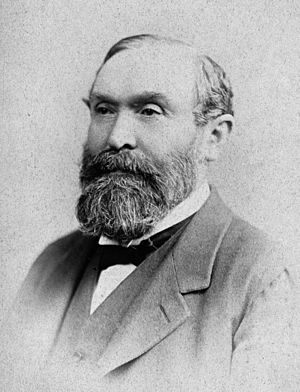William Rutherford (physiologist) facts for kids
William Rutherford (born April 20, 1839, died February 21, 1899) was a Scottish doctor and scientist. He studied how the human body works, which is called physiology. For 25 years, he taught physiology as a professor at the University of Edinburgh. He helped create new ways to study the body using experiments. He was also a special professor at the Royal Institution from 1872 to 1875.
Contents
Early Life and Education
William Rutherford was born on a farm called Ancrum Craig in Scotland. His father, Thomas Rutherford, was a farmer. William went to school at Jedburgh Grammar School. After that, he studied medicine at the University of Edinburgh. He earned his medical degree in 1863.
Studying in Europe
After finishing his studies in Edinburgh, William traveled to learn more. He studied in big cities like Berlin, Vienna, and Paris. When he came back, he became an assistant to John Hughes Bennett. Bennett was a professor of physiology at the University of Edinburgh.
New Ways to Study the Body
A scientist named John Goodsir told Professor Bennett about new ways to do experiments in physiology in Germany. William Rutherford and another doctor, Douglas Argyll Robertson, were the first in the United Kingdom to teach students these new methods. They used special equipment from famous scientists like Hermann von Helmholtz and Carl Ludwig. This helped students learn about the body in a hands-on way.
Rutherford's Career and Teaching
In 1869, William Rutherford became a special member of the Royal Society of Edinburgh. This was a big honor for scientists. That same year, he started working as an assistant professor at King's College, London. In 1871, he became a professor of physiology at the Royal Institution.
Returning to Edinburgh
In 1874, Rutherford returned to the University of Edinburgh. He took over from his old teacher, Professor Bennett, as the professor of physiology. Many years later, in 1878, he also became a member of the Aesculapian Club.
Inspiring a Famous Author
William Rutherford taught at the University of Edinburgh when the famous writer Arthur Conan Doyle was a medical student there. Conan Doyle later created the detective character Sherlock Holmes. He also created a character called Professor Challenger, who was partly based on William Rutherford. From 1881, a scientist named Sutherland Simpson worked as Rutherford's laboratory assistant.
Later Life and Legacy
William Rutherford passed away on February 21, 1899, in Edinburgh. He was not married and did not have children. He was buried with his parents in the churchyard at Ancrum. Another professor, Edward Albert Sharpey-Schafer, took over his teaching position at the University of Edinburgh. Rutherford's work helped shape how physiology is studied and taught today.
Works
William Rutherford wrote many scientific papers and books during his career. Here are some of his important works:
- On the morbid appearances met with in the brains of thirty insane persons (1869)
- Influence of the vagus upon the vascular system (1869)
- Introductory lecture to the course of physiology in Kings College, London, 1869 (1869)
- An introduction to the study of medicine : a lecture delivered at the opening of the medical session of 1871–72, in King's College, London (1871)
- The present aspects of physiology; an introductory lecture (1874)
- Outlines of practical histology : being the notes of the Histological Section of the Class of Practical Physiology held in the University of Edinburgh (1875)
- The sense of hearing: a lecture (1886)
- Syllabus of lectures on physiology (1887)
- A General account of histological methods (1887)
- On the conditions that influence the attainment of the physiological ideal : introductory lecture, 14 October 1890 (1890)
- The tercentenary of the compound microscope; an inaugural address delivered 7 November 1890, to the Scottish Microscopical Society (1891)
- On the method of studying a natural science such as physiology : an introductory lecture, delivered 9 October 1894 (1894)



